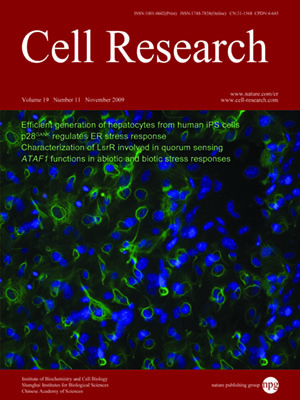
Volume 19, No 11, Nov 2009
ISSN: 1001-0602
EISSN: 1748-7838 2018
impact factor 17.848*
(Clarivate Analytics, 2019)
Volume 19 Issue 11, November 2009: 1233-1242
ORIGINAL ARTICLES
Efficient generation of hepatocyte-like cells from human induced pluripotent stem cells
Zhihua Song1,2, Jun Cai1, Yanxia Liu1, Dongxin Zhao1, Jun Yong1,2, Shuguang Duo1, Xijun Song1, Yushan Guo1,2, Yang Zhao1, Han Qin1,2, Xiaolei Yin1,2, Chen Wu1,2, Jie Che1, Shichun Lu3, Mingxiao Ding1 and Hongkui Deng1,2
1The MOE Key Laboratory of Cell Proliferation and Differentiation, Department of cell biology, College of Life Sciences, Box 38, Peking University, Beijing 100871, China
2Laboratory of Chemical Genomics, Shenzhen Graduate School of Peking University, Shenzhen 518055, China
3Beijing YouAn Hospital, Capital Medical University, Beijing 100069, China
Correspondence: Hongkui Deng,(hongkui_deng@p ku.edu.cn )
Human induced pluripotent stem (iPS) cells are similar to embryonic stem (ES) cells, and can proliferate intensively and differentiate into a variety of cell types. However, the hepatic differentiation of human iPS cells has not yet been reported. In this report, human iPS cells were induced to differentiate into hepatic cells by a stepwise protocol. The expression of liver cell markers and liver-related functions of the human iPS cell-derived cells were monitored and compared with that of differentiated human ES cells and primary human hepatocytes. Approximately 60% of the differentiated human iPS cells at day 7 expressed hepatic markers alpha fetoprotein and Alb. The differentiated cells at day 21 exhibited liver cell functions including albumin Asecretion, glycogen synthesis, urea production and inducible cytochrome P450 activity. The expression of hepatic markers and liver-related functions of the iPS cell-derived hepatic cells were comparable to that of the human ES cell-derived hepatic cells. These results show that human iPS cells, which are similar to human ES cells, can be efficiently induced to differentiate into hepatocyte-like cells.
Cell Research (2009) 19:1233-1242. doi: 10.1038/cr.2009.107; published online 8 September 2009
FULL TEXT | PDF
Browse 2544


